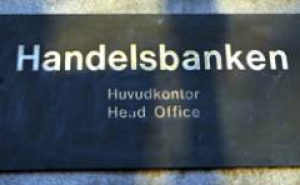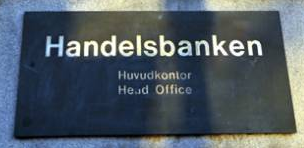Analys
SHB Råvarubrevet 22 oktober 2011
 Vårt Råvaruindex backade med någon procentenhet under veckan men marknaden fann stöd och riskaptiten tilltog efter förhoppningar om att de europeiska ledarna närmar sig en lösning på skuldkrisen samtidigt som Fed indikerade ett möjligt QE3. Kraftigt fall på råoljelagren samtidigt som Libyens oljeproduktion börjar återhämta sig. Gaddafi´s död påskyndar tidsplanen kring oljeproduktionen något men vi tror att uppstart av oljefält och reparationer kommer att ta mycket tid och kraft. Detta bör upprätthålla oljemarknaden något. Statoil meddelade i slutet av veckan att fyndigheten vid Aldus Major South i Nordsjön kan vara en av de största i norsk historia. I övrigt var det kraftiga fall på metaller men marknaderna återhämtade delar av rörelsen mot slutet av veckan.
Vårt Råvaruindex backade med någon procentenhet under veckan men marknaden fann stöd och riskaptiten tilltog efter förhoppningar om att de europeiska ledarna närmar sig en lösning på skuldkrisen samtidigt som Fed indikerade ett möjligt QE3. Kraftigt fall på råoljelagren samtidigt som Libyens oljeproduktion börjar återhämta sig. Gaddafi´s död påskyndar tidsplanen kring oljeproduktionen något men vi tror att uppstart av oljefält och reparationer kommer att ta mycket tid och kraft. Detta bör upprätthålla oljemarknaden något. Statoil meddelade i slutet av veckan att fyndigheten vid Aldus Major South i Nordsjön kan vara en av de största i norsk historia. I övrigt var det kraftiga fall på metaller men marknaderna återhämtade delar av rörelsen mot slutet av veckan.
Det är makroekonomisk oro som styr råvarumarknaden just nu och det är väl ingen överraskning att marknaden förväntar sig mycket långsam tillväxt i Europa, mycket långsam tillväxt i USA och avtagande tillväxt i Kina. Detta har inneburit att en stor del av analytikerkåren har reviderat ned sina prognoser på framför allt metaller. Vi har dock aldrig sett en sådan delad analytikerkår eftersom potentialen för dominoeffekt från enskilda händelser är mycket stor och ökar risken. På Koppar exempelvis pekar prognoserna på allt mellan 7,500 dollar och 10,500 dollar för den kommande 24 månaders perioden.
En hel del osäkerhet och en marknad som anpassat till en kraftig volatilitet kommer naturligtvis bjuda på möjligheter att komma in i råvarumarknaden på gynnsamma nivåer. Det är därför viktigt att belysa en längre placeringshorisont och råvaror ur ett diversifieringsperspektiv. Vi har studerat under vilka perioder sedan 1995 man INTE hade uppnått en lägre risk genom att inkludera råvaror i portföljen. Föga förvånande så har ett inkluderande av råvaror i sparportföljen under samtliga kvartal under denna period lett till en lägre risk. Med andra ord, det har undantagslöst förbättrat den riskjusterade avkastningen, det som är det absolut viktigaste sättet att generera avkastning.
Om vi då ser till det längre perspektivet kan vi inte komma runt det faktum att efterfrågan växer på en ändlig resurs. Om vi väljer att bryta ner vårt råvaruindex i underkomponenter skulle jag se det så här:
1) Ädelmetaller: Guld och silver har stigit kraftigt under nuvarande finanskris, drivet av sin status som värdebevarare i orostider. På kort sikt anser vi att denna våg är över, men att på lägre sikt så utgör ädelmetaller en bra försäkring i en diversifierad sparportfölj.
2) Basmetaller: Dessa höll sig höga långt in i årets börsfall och konjunkturoro, för att nyligen falla 15 % på en vecka. Här anser vi att det både på kort och lång sikt är bra köpläge, Kina och övriga tillväxtmarknader kommer att driva på efterfrågan, och fler aktörer hoppas på prisfall än vad som fruktar detsamma. Faller priset så dras utbud bort från marknaden då utvinning inte blir lönsam.
3) Livsmedel: Även här pekar både konsumtionsmönster och befolkningstillväxt på en ekvation som är svår att få ihop på sikt, fler människor ska äta och fler anammar västerländska konsumtionsmönster vilket leder till högre efterfrågan på kött och protein. Vi hoppas att mer spannmål kan produceras, och framför allt distribueras, till de som behöver, utan att kostnaderna stiger. Men risken är att det bara är högre priser som leder till ökade investeringar i jordbruk och spannmålsproduktion.
4) Energi: Ännu en omöjlig ekvation att lösa, efterfrågan på fossila bränslen stiger trots miljömedvetenhet, och de ”billiga” tillgångarna på råolja utarmas. All ny oljeutvinning sker till betydligt högre kostnader, vilket återspeglas i priset. Oljepriset samvarierar ganska väl med kortsiktiga konjunkturförväntningar, men kommer på sikt inte att kunna gå annat än upp som vi ser det.
Sammanvägt går det inte att dra någon annan slutsats än att råvaror kommer att stiga i pris. Kortsiktigt kommer de att vara fortsatt volatila och riskfyllda, särskilt i dessa finansiella orostider, men på längre sikt kommer de att stiga. Skulle dessutom börsen repa mod under återstoden av året så kommer råvarupriserna att stiga även kortsiktigt.
Handelsbankens Råvaruindex
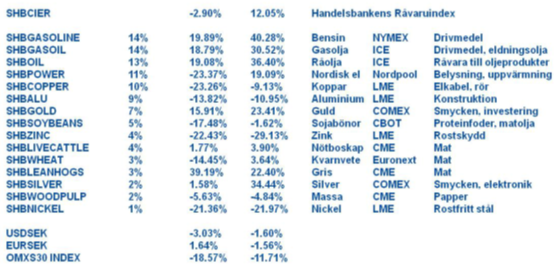
Handelsbankens råvaruindex består av de underliggande indexen för respektive råvara. Vikterna är bestämda till hälften från värdet av global produktion och till hälften från likviditeten i terminskontrakten.
[box]SHB Råvarubrevet är producerat av Handelsbanken och publiceras i samarbete och med tillstånd på Råvarumarknaden.se[/box]
Ansvarsbegränsning
Detta material är producerat av Svenska Handelsbanken AB (publ) i fortsättningen kallad Handelsbanken. De som arbetar med innehållet är inte analytiker och materialet är inte oberoende investeringsanalys. Innehållet är uteslutande avsett för kunder i Sverige. Syftet är att ge en allmän information till Handelsbankens kunder och utgör inte ett personligt investeringsråd eller en personlig rekommendation. Informationen ska inte ensamt utgöra underlag för investeringsbeslut. Kunder bör inhämta råd från sina rådgivare och basera sina investeringsbeslut utifrån egen erfarenhet.
Informationen i materialet kan ändras och också avvika från de åsikter som uttrycks i oberoende investeringsanalyser från Handelsbanken. Informationen grundar sig på allmänt tillgänglig information och är hämtad från källor som bedöms som tillförlitliga, men riktigheten kan inte garanteras och informationen kan vara ofullständig eller nedkortad. Ingen del av förslaget får reproduceras eller distribueras till någon annan person utan att Handelsbanken dessförinnan lämnat sitt skriftliga medgivande. Handelsbanken ansvarar inte för att materialet används på ett sätt som strider mot förbudet mot vidarebefordran eller offentliggörs i strid med bankens regler.
Finansiellt instruments historiska avkastning är inte en garanti för framtida avkastning. Värdet på finansiella instrument kan både öka och minska och det är inte säkert att du får tillbaka hela det investerade kapitalet.
Analys
What OPEC+ is doing, what it is saying and what we are hearing

Down 4.4% last week with more from OPEC+, a possible truce in Ukraine and weak US data. Brent crude fell 4.4% last week with a close of the week of USD 66.59/b and a range of USD 65.53-69.98/b. Three bearish drivers were at work. One was the decision by OPEC+ V8 to lift its quotas by 547 kb/d in September and thus a full unwind of the 2.2 mb/d of voluntary cuts. The second was the announcement that Trump and Putin will meet on Friday 15 August to discuss the potential for cease fire in Ukraine (without Ukraine). I.e. no immediate new sanctions towards Russia and no secondary sanctions on buyers of Russian oil to any degree that matters for the oil price. The third was the latest disappointing US macro data which indicates that Trump’s tariffs are starting to bite. Brent is down another 1% this morning trading close to USD 66/b. Hopes for a truce on the horizon in Ukraine as Putin meets with Trump in Alaska in Friday 15, is inching oil lower this morning.

Trump – Putin meets in Alaska. The potential start of a process. No disruption of Russian oil in sight. Trump has invited Putin to Alaska on 15 August to discuss Ukraine. The first such invitation since 2007. Ukraine not being present is bad news for Ukraine. Trump has already suggested ”swapping of territory”. This is not a deal which will be closed on Friday. But rather a start of a process. But Trump is very, very unlikely to slap sanctions on Russian oil while this process is ongoing. I.e. no disruption of Russian oil in sight.
What OPEC+ is doing, what it is saying and what we are hearing. OPEC+ V8 is done unwinding its 2.2 mb/d in September. It doesn’t mean production will increase equally much. Since it started the unwind and up to July (to when we have production data), the increase in quotas has gone up by 1.4 mb/d, while actual production has gone up by less than 0.7 mb/d. Some in the V8 group are unable to increase while others, like Russia and Iraq are paying down previous excess production debt. Russia and Iraq shouldn’t increase production before Jan and Mar next year respectively.
We know that OPEC+ has spare capacity which it will deploy back into the market at some point in time. And with the accelerated time-line for the redeployment of the 2.2 mb/d voluntary cuts it looks like it is happening fast. Faster than we had expected and faster than OPEC+ V8 previously announced.
As bystanders and watchers of the oil market we naturally combine our knowledge of their surplus spare capacity with their accelerated quota unwind and the combination of that is naturally bearish. Amid this we are not really able to hear or believe OPEC+ when they say that they are ready to cut again if needed. Instead we are kind of drowning our selves out in a combo of ”surplus spare capacity” and ”rapid unwind” to conclude that we are now on a highway to a bear market where OPEC+ closes its eyes to price and blindly takes back market share whatever it costs. But that is not what the group is saying. Maybe we should listen a little.
That doesn’t mean we are bullish for oil in 2026. But we may not be on a ”highway to bear market” either where OPEC+ is blind to the price.
Saudi OSPs to Asia in September at third highest since Feb 2024. Saudi Arabia lifted its official selling prices to Asia for September to the third highest since February 2024. That is not a sign that Saudi Arabia is pushing oil out the door at any cost.
Saudi Arabia OSPs to Asia in September at third highest since Feb 2024

Analys
Breaking some eggs in US shale

Lower as OPEC+ keeps fast-tracking redeployment of previous cuts. Brent closed down 1.3% yesterday to USD 68.76/b on the back of the news over the weekend that OPEC+ (V8) lifted its quota by 547 kb/d for September. Intraday it traded to a low of USD 68.0/b but then pushed higher as Trump threatened to slap sanctions on India if it continues to buy loads of Russian oil. An effort by Donald Trump to force Putin to a truce in Ukraine. This morning it is trading down 0.6% at USD 68.3/b which is just USD 1.3/b below its July average.

Only US shale can hand back the market share which OPEC+ is after. The overall picture in the oil market today and the coming 18 months is that OPEC+ is in the process of taking back market share which it lost over the past years in exchange for higher prices. There is only one source of oil supply which has sufficient reactivity and that is US shale. Average liquids production in the US is set to average 23.1 mb/d in 2025 which is up a whooping 3.4 mb/d since 2021 while it is only up 280 kb/d versus 2024.
Taking back market share is usually a messy business involving a deep trough in prices and significant economic pain for the involved parties. The original plan of OPEC+ (V8) was to tip-toe the 2.2 mb/d cuts gradually back into the market over the course to December 2026. Hoping that robust demand growth and slower non-OPEC+ supply growth would make room for the re-deployment without pushing oil prices down too much.
From tip-toing to fast-tracking. Though still not full aggression. US trade war, weaker global growth outlook and Trump insisting on a lower oil price, and persistent robust non-OPEC+ supply growth changed their minds. Now it is much more fast-track with the re-deployment of the 2.2 mb/d done already by September this year. Though with some adjustments. Lifting quotas is not immediately the same as lifting production as Russia and Iraq first have to pay down their production debt. The OPEC+ organization is also holding the door open for production cuts if need be. And the group is not blasting the market with oil. So far it has all been very orderly with limited impact on prices. Despite the fast-tracking.
The overall process is nonetheless still to take back market share. And that won’t be without pain. The good news for OPEC+ is of course that US shale now is cooling down when WTI is south of USD 65/b rather than heating up when WTI is north of USD 45/b as was the case before.
OPEC+ will have to break some eggs in the US shale oil patches to take back lost market share. The process is already in play. Global oil inventories have been building and they will build more and the oil price will be pushed lower.
A Brent average of USD 60/b in 2026 implies a low of the year of USD 45-47.5/b. Assume that an average Brent crude oil price of USD 60/b and an average WTI price of USD 57.5/b in 2026 is sufficient to drive US oil rig count down by another 100 rigs and US crude production down by 1.5 mb/d from Dec-25 to Dec-26. A Brent crude average of USD 60/b sounds like a nice price. Do remember though that over the course of a year Brent crude fluctuates +/- USD 10-15/b around the average. So if USD 60/b is the average price, then the low of the year is in the mid to the high USD 40ies/b.
US shale oil producers are likely bracing themselves for what’s in store. US shale oil producers are aware of what is in store. They can see that inventories are rising and they have been cutting rigs and drilling activity since mid-April. But significantly more is needed over the coming 18 months or so. The faster they cut the better off they will be. Cutting 5 drilling rigs per week to the end of the year, an additional total of 100 rigs, will likely drive US crude oil production down by 1.5 mb/d from Dec-25 to Dec-26 and come a long way of handing back the market share OPEC+ is after.
Analys
More from OPEC+ means US shale has to gradually back off further

The OPEC+ subgroup V8 this weekend decided to fully unwind their voluntary cut of 2.2 mb/d. The September quota hike was set at 547 kb/d thereby unwinding the full 2.2 mb/d. This still leaves another layer of voluntary cuts of 1.6 mb/d which is likely to be unwind at some point.

Higher quotas however do not immediately translate to equally higher production. This because Russia and Iraq have ”production debts” of cumulative over-production which they need to pay back by holding production below the agreed quotas. I.e. they cannot (should not) lift production before Jan (Russia) and March (Iraq) next year.
Argus estimates that global oil stocks have increased by 180 mb so far this year but with large skews. Strong build in Asia while Europe and the US still have low inventories. US Gulf stocks are at the lowest level in 35 years. This strong skew is likely due to political sanctions towards Russian and Iranian oil exports and the shadow fleet used to export their oil. These sanctions naturally drive their oil exports to Asia and non-OECD countries. That is where the surplus over the past half year has been going and where inventories have been building. An area which has a much more opaque oil market. Relatively low visibility with respect to oil inventories and thus weaker price signals from inventory dynamics there.
This has helped shield Brent and WTI crude oil price benchmarks to some degree from the running, global surplus over the past half year. Brent crude averaged USD 73/b in December 2024 and at current USD 69.7/b it is not all that much lower today despite an estimated global stock build of 180 mb since the end of last year and a highly anticipated equally large stock build for the rest of the year.
What helps to blur the message from OPEC+ in its current process of unwinding cuts and taking back market share, is that, while lifting quotas, it is at the same time also quite explicit that this is not a one way street. That it may turn around make new cuts if need be.
This is very different from its previous efforts to take back market share from US shale oil producers. In its previous efforts it typically tried to shock US shale oil producers out of the market. But they came back very, very quickly.
When OPEC+ now is taking back market share from US shale oil it is more like it is exerting a continuous, gradually increasing pressure towards US shale oil rather than trying to shock it out of the market which it tried before. OPEC+ is now forcing US shale oil producers to gradually back off. US oil drilling rig count is down from 480 in Q1-25 to now 410 last week and it is typically falling by some 4-5 rigs per week currently. This has happened at an average WTI price of about USD 65/b. This is very different from earlier when US shale oil activity exploded when WTI went north of USD 45/b. This helps to give OPEC+ a lot of confidence.
Global oil inventories are set to rise further in H2-25 and crude oil prices will likely be forced lower though the global skew in terms of where inventories are building is muddying the picture. US shale oil activity will likely decline further in H2-25 as well with rig count down maybe another 100 rigs. Thus making room for more oil from OPEC+.
-

 Nyheter4 veckor sedan
Nyheter4 veckor sedanUSA inför 93,5 % tull på kinesisk grafit
-

 Nyheter3 veckor sedan
Nyheter3 veckor sedanFusionsföretag visar hur guld kan produceras av kvicksilver i stor skala – alkemidrömmen ska bli verklighet
-

 Nyheter4 veckor sedan
Nyheter4 veckor sedanWestinghouse planerar tio nya stora kärnreaktorer i USA – byggstart senast 2030
-

 Nyheter2 veckor sedan
Nyheter2 veckor sedanKopparpriset i fritt fall i USA efter att tullregler presenterats
-

 Nyheter3 veckor sedan
Nyheter3 veckor sedanRyska militären har skjutit ihjäl minst 11 guldletare vid sin gruva i Centralafrikanska republiken
-
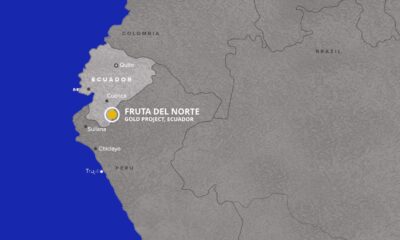
 Nyheter2 veckor sedan
Nyheter2 veckor sedanLundin Gold rapporterar enastående borrresultat vid Fruta del Norte
-
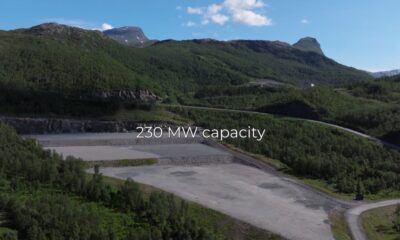
 Nyheter2 veckor sedan
Nyheter2 veckor sedanStargate Norway, AI-datacenter på upp till 520 MW etableras i Narvik
-

 Nyheter4 veckor sedan
Nyheter4 veckor sedanKina skärper kontrollen av sällsynta jordartsmetaller, vill stoppa olaglig export



